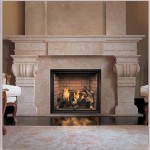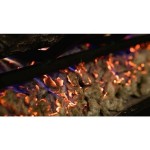Outdoor Fireplace Wood Storage: A Comprehensive Guide
An outdoor fireplace offers a focal point for entertainment and relaxation, extending living spaces into the backyard. However, maximizing the enjoyment of an outdoor fireplace requires careful consideration of the logistical aspects, particularly the storage of firewood. Proper wood storage is essential for maintaining dry, burnable fuel, protecting the wood from pests and rot, and enhancing the aesthetic appeal of the outdoor space.
This article delves into the crucial elements of outdoor fireplace wood storage, encompassing the selection of suitable storage locations, the appropriate types of storage structures, and practical tips for preserving the quality and longevity of the firewood supply. The aim is to provide comprehensive guidance for homeowners seeking to integrate functional and visually appealing wood storage solutions within their outdoor fireplace setting.
Selecting the Optimal Location for Wood Storage
The location of firewood storage is a primary determinant of its preservation. Factors such as sunlight exposure, drainage, proximity to the fireplace, and aesthetic integration should all be evaluated when choosing a site.
First and foremost, the chosen location must facilitate adequate drainage. Wood that sits directly on the ground is prone to absorbing moisture, fostering rot and attracting insects. Therefore, selecting a location with a natural grade that allows water to flow away from the woodpile is critical. If the ground is level, consider creating a slightly elevated platform using gravel, concrete pavers, or a purpose-built wood storage base.
Sunlight plays a dual role in wood storage. While direct sunlight can aid in drying out wood, excessive exposure can also lead to fading and cracking, particularly in seasoned wood. A location that receives partial sunlight, particularly during the morning hours, is often ideal. This allows for sufficient drying without subjecting the wood to the harsh afternoon sun.
Proximity to the outdoor fireplace is another important consideration. Ideally, the wood storage should be located within a reasonable distance of the fire pit to minimize the effort required to transport wood. However, it should also be far enough away to prevent sparks or embers from igniting the woodpile. A distance of at least 10 feet is generally recommended.
Finally, the location should be aesthetically integrated with the overall outdoor space. Consider the surrounding landscaping and architectural features when selecting a site. A well-placed wood storage structure can enhance the visual appeal of the fireplace area, while a poorly chosen location can detract from it.
Types of Outdoor Fireplace Wood Storage Structures
Numerous storage structures can be employed to protect firewood from the elements and maintain its quality. The choice of structure depends on factors such as budget, available space, aesthetic preferences, and the quantity of wood to be stored.
Simple Wood Racks: These represent the most basic and often most economical storage option. Wood racks typically consist of a metal or wooden frame that elevates the wood off the ground. They are available in various sizes and styles, from small, portable racks to larger, more substantial structures. While wood racks offer basic protection, they generally do not provide complete coverage from rain or snow. Therefore, they are best suited for drier climates or locations where the wood is partially sheltered by an overhang.
Covered Wood Sheds: Wood sheds offer a higher level of protection from the elements. These structures typically feature a roof and partial or complete walls, shielding the wood from rain, snow, and wind. Wood sheds can be constructed from a variety of materials, including wood, metal, or even repurposed shipping containers. They can be freestanding or attached to an existing structure, such as a garage or shed. A key consideration when building or purchasing a wood shed is ensuring proper ventilation. Good airflow is essential for preventing moisture buildup and promoting drying. This can be achieved through strategically placed vents or by leaving gaps between the wall boards.
Custom-Built Wood Storage: For homeowners seeking a more personalized solution, custom-built wood storage offers the greatest flexibility in terms of design and functionality. Custom structures can be tailored to match the aesthetic of the outdoor fireplace and surrounding landscape. They can incorporate features such as built-in seating, decorative elements, and even integrated lighting. Custom-built wood storage often requires more planning and investment than other options, but it can result in a truly unique and functional addition to the outdoor space.
Creative Repurposing: Beyond traditional structures, homeowners can explore creative repurposing options for wood storage. Old pallets, metal drums, or even discarded furniture can be transformed into functional and visually appealing storage solutions. Repurposing materials not only reduces waste but also adds a unique and rustic character to the outdoor space. When repurposing materials, it is essential to ensure that they are clean, safe, and structurally sound.
Regardless of the chosen structure, it's crucial to ensure that it is stable and securely anchored to the ground. This is particularly important in areas prone to high winds or earthquakes. A well-built and properly maintained wood storage structure will provide years of reliable service and protect the firewood from the elements.
Practical Tips for Preserving Firewood Quality
Beyond selecting the right location and storage structure, several practical tips can help maintain the quality and longevity of the firewood supply. These tips focus on proper stacking techniques, seasoning methods, and pest control measures.
Proper Stacking Techniques: The way firewood is stacked can significantly impact its drying rate and overall quality. The primary goal of stacking is to promote airflow throughout the woodpile. This can be achieved by leaving small gaps between individual pieces of wood and by stacking the wood in rows that are oriented in the same direction. A common stacking method involves creating a "crib" or "holzhaufen" shape, which involves stacking the wood in a circular or octagonal pattern with a hollow center. This allows for maximum airflow and promotes even drying. Another effective technique is to stack the wood in alternating layers, with each layer oriented perpendicular to the previous one. This creates a stable and well-ventilated woodpile.
Seasoning the Wood: Seasoning refers to the process of drying out firewood to reduce its moisture content. Properly seasoned wood burns more efficiently, produces less smoke, and reduces the risk of creosote buildup in the chimney. The seasoning process typically takes several months, depending on the type of wood, the climate, and the stacking method. Hardwoods, such as oak and maple, generally require a longer seasoning period than softwoods, such as pine and fir. To accelerate the seasoning process, split the wood into smaller pieces, stack it loosely, and ensure that it is exposed to ample sunlight and airflow. A moisture meter can be used to check the moisture content of the wood. Ideally, the moisture content should be below 20% before burning.
Pest Control Measures: Firewood can attract a variety of pests, including insects, rodents, and fungi. These pests can damage the wood and even infest the home if the wood is brought indoors. To minimize the risk of pest infestations, it is essential to keep the woodpile clean and free of debris. Remove any rotting wood or vegetation from the area surrounding the woodpile. Consider using a pest-resistant wood species, such as cedar or redwood. Store the wood off the ground to prevent it from coming into contact with soil-dwelling pests. Regularly inspect the woodpile for signs of infestation, such as holes, sawdust, or insect droppings. If an infestation is detected, treat the wood with an appropriate insecticide or fungicide.
Regular Maintenance: Wood storage areas require routine maintenance to ensure optimal conditions for preserving the firewood supply. This included cleaning the wood rack or shed of debris, inspecting the structure for signs of damage, and restacking wood piles that have fallen or become unstable. Timely maintenance prevents potential issues from escalating. It also contributes to safety and organization of the wood storage area.
By adhering to these practical tips, homeowners can ensure that their firewood remains dry, clean, and free of pests, providing a reliable and enjoyable source of fuel for their outdoor fireplace.

Customize Your Fireplace Add Wood Storage Boxes Seatwalls And More

Customize Your Fireplace Add Wood Storage Boxes Seatwalls And More

Customize Your Fireplace Add Wood Storage Boxes Seatwalls And More

Wonderful Wood Storage Dress Up Your Stack Ep Henry

Outdoor Fireplace With Wood Storage

3 Firewood Storage Ideas For Your Custom Fireplace Or Fire Pit

Excellent Photo Outdoor Fireplace With Wood Storage Suggestions Patio Backyard Living

Customize Your Fireplace Add Wood Storage Boxes Seatwalls And More

Wood Storage Boxes Firefarm Living

Outdoor Fireplace Wood Storage Design Ideas
Related Posts








